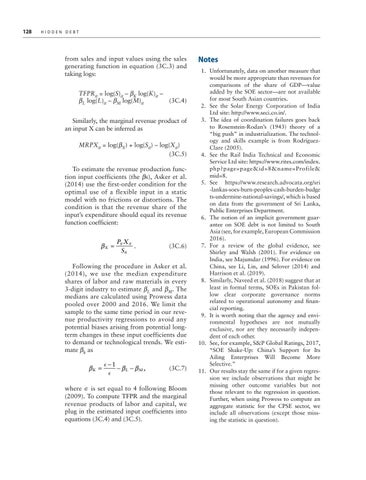128
H IDDEN DEBT
from sales and input values using the sales generating function in equation (3C.3) and taking logs: TFPRit = log(S)it – βK log(K)it – βL log(L)it – βM log(M)it (3C.4) Similarly, the marginal revenue product of an input X can be inferred as MRPXit = log(βX) + log(Sit) – log(Xit) (3C.5) To estimate the revenue production function input coefficients (the βs), Asker et al. (2014) use the first-order condition for the optimal use of a flexible input in a static model with no frictions or distortions. The condition is that the revenue share of the input’s expenditure should equal its revenue function coefficient:
βX =
Pit X it . S it
(3C.6)
Following the procedure in Asker et al. (2014), we use the median expenditure shares of labor and raw materials in every 3-digit industry to estimate βL and βM. The medians are calculated using Prowess data pooled over 2000 and 2016. We limit the sample to the same time period in our revenue productivity regressions to avoid any potential biases arising from potential longterm changes in these input coefficients due to demand or technological trends. We estimate βk as
βK =
−1 − βL − β M , (3C.7)
where ∈ is set equal to 4 following Bloom (2009). To compute TFPR and the marginal revenue products of labor and capital, we plug in the estimated input coefficients into equations (3C.4) and (3C.5).
Notes 1. Unfortunately, data on another measure that would be more appropriate than revenues for comparisons of the share of GDP—value added by the SOE sector—are not available for most South Asian countries. 2. See the Solar Energy Corporation of India Ltd site: http://www.seci.co.in/. 3. The idea of coordination failures goes back to Rosenstein-Rodan’s (1943) theory of a “big push” in industrialization. The technology and skills example is from RodríguezClare (2005). 4. See the Rail India Technical and Economic Service Ltd site: https://www.rites.com/index. php?page=page&id=8&name=Profile& mid=8. 5. See https://www.research.advocata.org/sri -lankas-soes-burn-peoples-cash-burden-budge ts-undermine-national-savings/, which is based on data from the government of Sri Lanka, Public Enterprises Department. 6. The notion of an implicit government guarantee on SOE debt is not limited to South Asia (see, for example, European Commission 2016). 7. For a review of the global evidence, see Shirley and Walsh (2001). For evidence on India, see Majumdar (1996). For evidence on China, see Li, Lin, and Selover (2014) and Harrison et al. (2019). 8. Similarly, Naveed et al. (2018) suggest that at least in formal terms, SOEs in Pakistan follow clear corporate governance norms related to operational autonomy and financial reporting. 9. It is worth noting that the agency and environmental hypotheses are not mutually exclusive, nor are they necessarily independent of each other. 10. See, for example, S&P Global Ratings, 2017, “SOE Shake-Up: China’s Support for Its Ailing Enterprises Will Become More Selective.” 11. Our results stay the same if for a given regression we include observations that might be missing other outcome variables but not those relevant to the regression in question. Further, when using Prowess to compute an aggregate statistic for the CPSE sector, we include all observations (except those missing the statistic in question).

